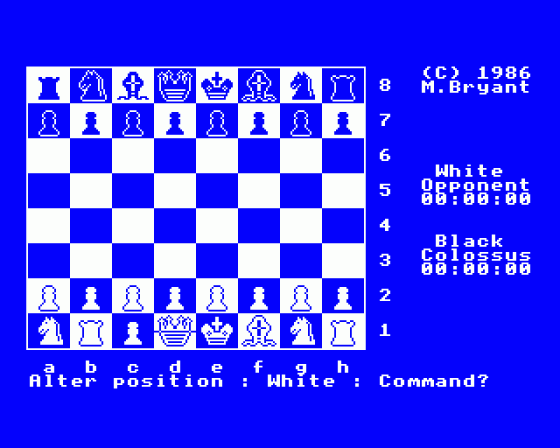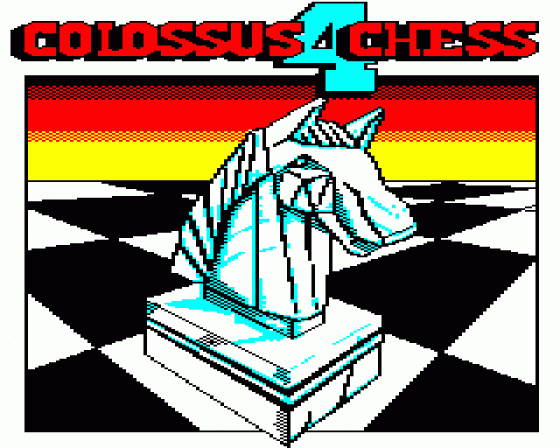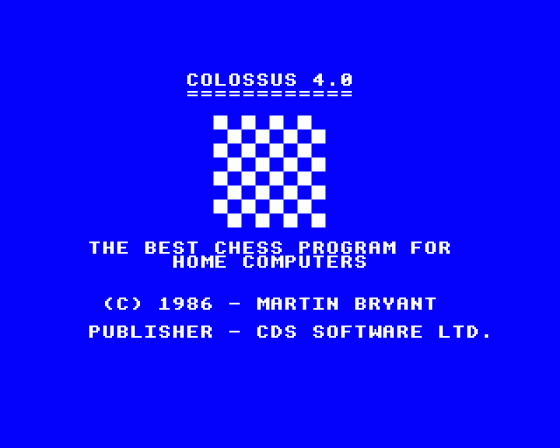
Beebug
 1st March 1987
1st March 1987
Categories: Review: Software
Author: Bernard Hill
Publisher: CDS
Machine: BBC/Electron
Published in Beebug Volume 5 Number 9
BBC Soft's White Knight has been the undisputed chess champion on the Beeb. Now a new challenger has arrived on the scene in the form of Colossus Chess 4.0, Bernard Hill, no mean player himself, has been refereeing the match.
Colossus 4 Chess
Any new chess program for the Beeb written by Martin Bryant must be worth looking at. In Computer Chess circles, Martin's nine years' experience makes him quite an old timer, but unlike many chess programmers he has put his efforts into the home computer market. Previous versions of Colossus are already well known to owners of other computers, and Martin's previous BBC programs were White Knight Mk 11 and 12 published by BBC Soft.
Colossus is available on tape or disc (40 track or 80 track - state which) for the Electron, BBC, B+ and Master. A Master Compact version will be available shortly, and disc versions contain programs for Model B and an expanded version for the B+ or Master. The existence of both versions on one disc means you have no problems if you upgrade to a Master!
Just browsing through the manual shows the similarity to White Knight, particularly that program's excellent command interface. There is no need to go to other menu screens to perform functions such as saving or reloading games, changing levels, sides or turning the board round. Even the colours used for the display, or the volume of the beep can be changed! It is extremely easy to set up positions for analysis or problem solving, and the current elapsed time for each player is shown at the right of the playing board. Sadly, I think the screen layout is inferior to that of the older program: if you are playing white, your move and elapsed time is shown opposite the black pieces and vice-versa.

The manual indicates that the program version which loads in to a Model B or Electron is different to that for the Master or B+, and the board display shows this very clearly. The 32K program displays less than a full mode 4 screen as the program loads right up to &6040! On the 64K models, mode 132 is used of course, which enables a 3-dimensional view of the board and pieces to be displayed. This is not the only difference, however, as a great many features of the larger program are omitted in the smaller. Even worse, some features present in White Knight are missing in 32K Colossus. In particular, the inability of the 32K program to save and reload games is a major drawback, and you should consider carefully if you are a Model B or Electron owner, as many features are unavailable.
Firstly, that 3D screen. After a few minutes, the novelty wears off, and with relief I used the 2D-screen option to revert to my familiar White Knight-style pieces. The problem is not with my monitor, but with the Mode 132 graphics. Perhaps Mode 128 would handle it better but then the text would be too small for TV sets. The other annoying thing about the 3D graphics is that it takes almost ten seconds to draw the initial board, compared to under 1.5 seconds for the 2D board. So no bonus points for this fashionable feature!
On the 64K version are the on-screen features which made White Knight such an interesting program to play even when you are waiting for it to move. The line of play the computer considers best so far is shown (first move only with the 32K program), but even more interestingly, the large program shows that moves are currently being considered. This is quite an insight into how the program is performing its search, and quite a shock to see that this section of the display continues to flicker and change when you are thinking. It really is thinking in your time!

The annoying thing, however, from a practical player's viewpoint, is that there seems to be no way to turn off this "hint". There is an option to vary the amount of information displayed here, and contrary to the implication of the manual I observe that the playing speed is 4-5 times slower when showing the full list.
Since one of White Knight's weaknesses had been a lack of stored opening sequences, I was pleased to find that the 64K version has a small (3000 move) book of opening moves available. In practice, however, this is a little disappointing and does not seem to be very varied. For instance, for the first move it chooses in about equal proportion between e2e4, d2d4, and b1c3; with a rare try at c2c4. In reply to e2e4 (again in approximately equal proportion) we have e7e5; e7e6; g8f6; b8c6; d7d5; with a rare c7c5. While I respect Martin Bryant's quoted viewpoint that a careful choice of opening repertoire is necessary to give the best computer play, I feel that most players will want a more varied selection to practise against. At least pressing the U key will make the computer select another instead of the rare b1c3.
The White Knight owner would find himself familiar with the take-back (and forward) facility; changing of time-clock; legal move demonstration; play-self and supervisor modes, and invisible pieces (now expanded to leave one side still visible). New options are available to watch a replay of your defeat (?), and (large version) have the computer recant and choose a different move. More importantly, the modes-of-play options have been expanded: options are still available to set firm time limits (e.g. 40 moves in two hours); set average time limits (e.g. one move per three minutes); or match your play rate, but an 'infinite' mode has been added, and, more excitingly, a limited-time mode (e.g. all the moves in ten minutes each). If you use the latter I advise you to set the computer's clock forward slightly to compensate for your move entry time - and beware, Colossus claims a win if you run out of time! Also new is the expansion of the mate-finding mode to include self-mates and help-mates, while disc versions also come with tfiles of 34 famous computer games and 19 problems, but only 64K users can load them!
But hat of the most important aspect - the standard of play? The manual claims a grading of 1850 ELO/165 BCF and that it beats White Knight Mk12 75% (Mk11 93%) of the time. It would need some weeks to evaluate the all-round strength play of a program but nothing I have seen leads me to disbelieve the above. The endgame algorithms have also been improved and I can confirm the manual's claim to be able to win the bishop+knight mate but on the ten second move level it couldn't win the King+Pawn v King ending against me.
So it is a good buy? For the Master or B+ owner I must give a resounding "Yes" and endorse the title screen's claim to be the best chess program for home computers, and at a remarkably low price for such a major piece of software design. But for the Model B owner, only a "Possibly". If you are prepared to play without a game-save option and don't want to watch the analysis, then the better play and limited-time modes will make your purchase worthwhile. And, of course, it will still work (and better) if you do later upgrade to the Master or B+.
Other Reviews Of Colossus Chess 4 For The BBC/Electron
Colossus Chess 4 (CDS)
A review by Dave Reeder (A&B Computing)
Colossus Chess 4 (CDS)
Challenging Chess
Colossus Chess 4 (CDS)
A review by Steve Brook (The Micro User)




